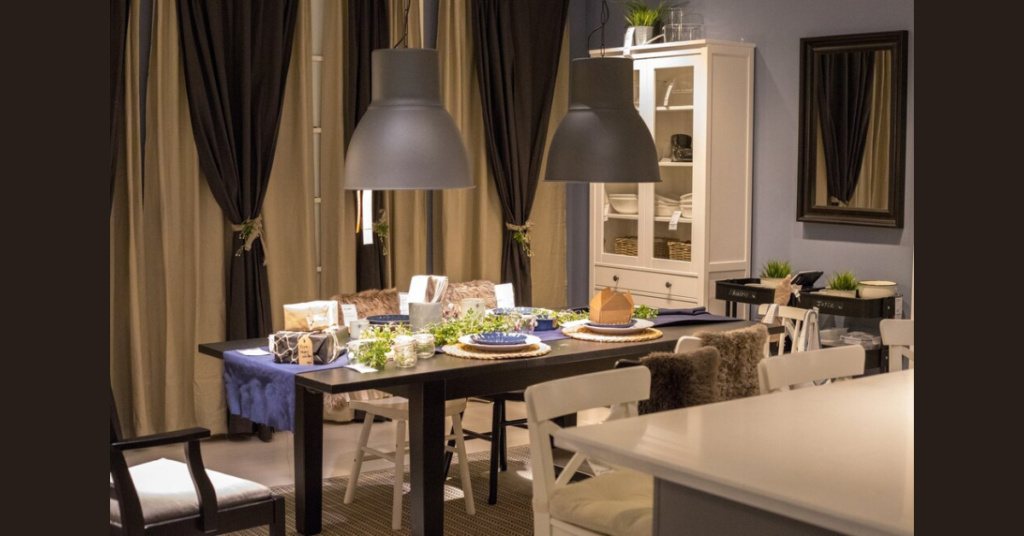The concept (Disappearing Dining Rooms) of the dining room has undergone significant transformation over the years, evolving from a formal, dedicated space in the home to a more fluid and multifunctional area. The term “disappearing dining rooms” reflects this shift, highlighting the trend towards integrating dining spaces into open-plan layouts and multifunctional areas. This article explores the historical context, current trends, and future possibilities for dining rooms, examining how societal changes, architectural innovations, and lifestyle preferences have influenced their evolution.
Historical Context of Dining Rooms
Early Dining Rooms
In the early 19th century, dining rooms were a formal and distinct area of the home, designed to accommodate elaborate meals and social gatherings. The dining room was typically separated from other areas of the house, featuring ornate furnishings and decor. The importance of the dining room was evident in the grand dining tables, fine china, and elaborate table settings that characterized these spaces.
The Rise of Open-Plan Living
The 20th century saw a significant shift in architectural and interior design, with the rise of open-plan living. This design philosophy emphasized fluidity and connectivity between different areas of the home, breaking down traditional barriers between rooms. The dining room, once a separate and formal space, began to merge with other living areas, such as the kitchen and living room. This trend was driven by changes in family dynamics, social norms, and lifestyle preferences.
Current Trends in Dining Spaces
The Integration of Dining Areas
Today, dining rooms are increasingly integrated into open-plan spaces, reflecting a shift towards more informal and versatile living environments. This integration often involves combining the dining area with the kitchen and living room, creating a cohesive and multifunctional space. The emphasis is on flexibility, allowing the dining area to adapt to various uses and activities.
Multifunctional Spaces
The trend towards multifunctional spaces is evident in modern homes, where dining areas often serve multiple purposes. For example, dining tables may double as workstations or play areas for children. This multifunctionality is facilitated by the use of adaptable furniture, such as extendable tables and modular seating.
Minimalism and Simplification
Minimalist design has also influenced the evolution of dining rooms. Contemporary dining spaces often feature clean lines, simple furniture, and a focus on functionality. The emphasis is on creating a serene and uncluttered environment, which contrasts with the more ornate and elaborate dining rooms of the past.
The Impact of Lifestyle and Social Changes
Shifts in Dining Habits
Changes in dining habits have significantly impacted the role and design of dining rooms. The increasing popularity of casual dining, takeout, and home delivery has reduced the emphasis on formal dining settings. Families and individuals are spending less time in dedicated dining spaces and more time in informal, multifunctional areas.
Remote Work and Home Offices
The rise of remote work has also influenced the design of dining spaces. As more people work from home, dining areas are being adapted to accommodate home offices and other work-related activities. This trend has led to the creation of flexible spaces that can easily transition between dining, working, and relaxing.
Environmental and Health Considerations
Environmental and health considerations are shaping the design of modern dining rooms. There is a growing emphasis on sustainable materials, energy efficiency, and healthy living. Dining spaces are incorporating elements such as natural lighting, indoor plants, and eco-friendly materials to create a healthier and more environmentally conscious environment.
The Future of Dining Rooms
Innovative Design Concepts
The future of dining rooms is likely to be characterized by continued innovation in design and functionality. Emerging trends include the use of smart technology, such as automated lighting and temperature control, to enhance the dining experience. Additionally, there is a growing interest in modular and adaptable furniture that can easily be reconfigured to meet changing needs.
The Role of Technology
Technology will play a significant role in shaping the future of dining rooms. Smart home systems and connected appliances are expected to become more prevalent, offering features such as voice-controlled lighting, integrated entertainment systems, and advanced cooking appliances. These technological advancements will contribute to a more seamless and enjoyable dining experience.
The Influence of Global Design Trends
Global design trends are likely to influence the future of dining rooms, with an emphasis on cross-cultural aesthetics and international design influences. The integration of global design elements, such as diverse materials and styles, will contribute to a more eclectic and personalized dining environment.
Conclusion
Disappearing Dining Rooms – The concept of the dining room has evolved significantly over the years, reflecting changes in societal norms, lifestyle preferences, and architectural trends. From its origins as a formal and dedicated space to its current role as a multifunctional and integrated area, the dining room continues to adapt to the needs of modern living. As we look to the future, innovative design concepts, technological advancements, and global influences will shape the continued evolution of dining spaces, offering new possibilities for how we dine and interact in our homes.







